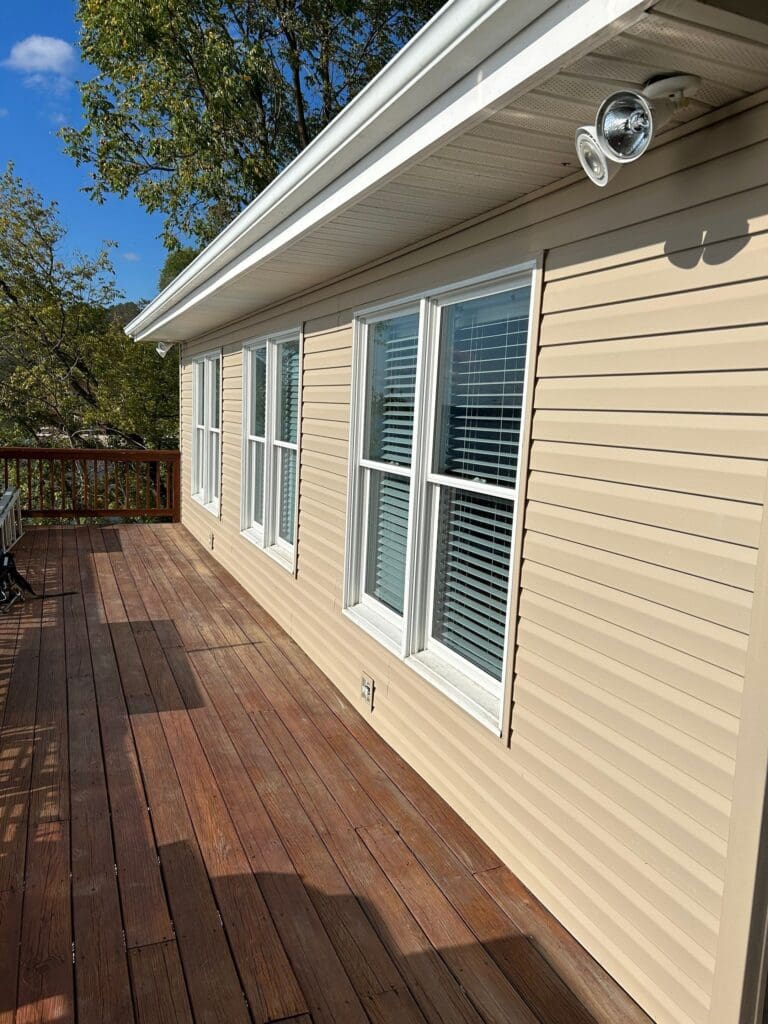
Vinyl siding is one of the most popular exterior options for homeowners, and for good reason. It’s affordable, low-maintenance, and comes in a variety of colors and styles. But like any exterior surface, it’s not invincible. From stray baseballs to lawn mower mishaps, small holes and cracks can happen, and when they do, it’s best not to ignore them.
In this post, we’ll explain what vinyl siding is, walk you through how to repair holes in vinyl siding (with and without replacing panels), and help you decide when it’s time to call in a professional like Diversified Roofing Co.
What Is Vinyl Siding, Anyway?
Vinyl siding is a type of plastic exterior cladding made from polyvinyl chloride (PVC). It’s designed to mimic the look of wood siding while being more weather-resistant, pest-proof, and budget-friendly. Vinyl siding is installed in horizontal or vertical interlocking panels and usually doesn’t require painting or staining—just a good rinse every so often.
Thanks to its flexibility and durability, vinyl siding can stand up to a lot. But sharp impacts or extreme temperature shifts can still cause holes, cracks, or warping.
Common Causes of Vinyl Siding Damage
Before we jump into how to repair it, let’s talk about why vinyl siding gets damaged in the first place:
- Flying debris during storms
- Accidents with lawn equipment like trimmers or mowers
- Stray sports balls (looking at you, backyard baseball games!)
- Wildlife or insects chewing or nesting
- UV exposure and age, causing brittleness and cracks
- Improper installation leading to shifting or warping
The good news? Most minor damage can be repaired quickly and affordably—if caught early.
How to Repair Holes in Vinyl Siding
Option 1: Small Hole or Crack? Patch It Yourself
If the hole is small—think less than 1.5 inches—you can usually repair it without replacing the whole panel.
What you’ll need:
- Exterior-grade caulk (color-matched if possible)
- Utility knife or sandpaper
- Rubbing alcohol or vinyl-safe cleaner
- Clean rag
Steps:
- Clean the damaged area thoroughly. Dirt or mold will prevent the patch from sticking.
- Trim any loose edges around the hole with a utility knife.
- Apply caulk generously to fill the hole or crack.
- Smooth it out with a damp finger or putty knife.
- Let it dry, then lightly sand for a smoother finish if needed.
Pro tip: Some brands offer color-matched vinyl patch kits that blend seamlessly with your siding.
Option 2: Bigger Damage? Replace the Panel
If the hole is large or the panel is cracked beyond repair, replacement is the way to go. Luckily, with vinyl’s interlocking design, you don’t have to remove the whole wall.
What you’ll need:
- Replacement vinyl siding panel (same style and color)
- Zip tool (siding removal tool)
- Hammer and nails or siding fasteners
Steps:
- Use the zip tool to unlock the damaged panel from the one above it.
- Gently pull out nails or fasteners securing the broken panel.
- Slide the new panel into place and fasten it.
- Relock the top panel using the zip tool to complete the install.
Not feeling confident in the process? Don’t worry—that’s where we come in.
When to Call a Professional
While DIY repair can be tempting, here are some good reasons to call us right away
- You can’t match the siding color or style
- The panel is warped or melted (common near grills)
- There are multiple damaged areas
- The damage is near corners, windows, or roofing transitions
- You’re unsure how to remove or reinstall panels safely
We’ll make sure the repair is done right—and blends in perfectly with the rest of your home.
How Much Does Vinyl Siding Repair Cost?
Repair costs can vary depending on the size and location of the damage. Here’s a rough estimate:
- Minor caulk-and-patch repairs: $50–$150
- Single panel replacement: $100–$300
- Extensive damage requiring multiple panels: $500+
Of course, these are just ballpark numbers. The best way to know what you’re looking at is to schedule a quick inspection—we’ll provide a transparent quote, no surprises.
Final Thoughts: Don’t Let Small Siding Damage Grow
Vinyl siding is built to last, but like any exterior, it needs a little TLC now and then. Small holes and cracks can let in moisture, pests, and cold air if left unchecked, leading to much bigger (and costlier) problems.
Whether you want to handle it yourself or let our pros at Diversified Roofing take care of it, we’re here to help you protect what matters most—your home.
